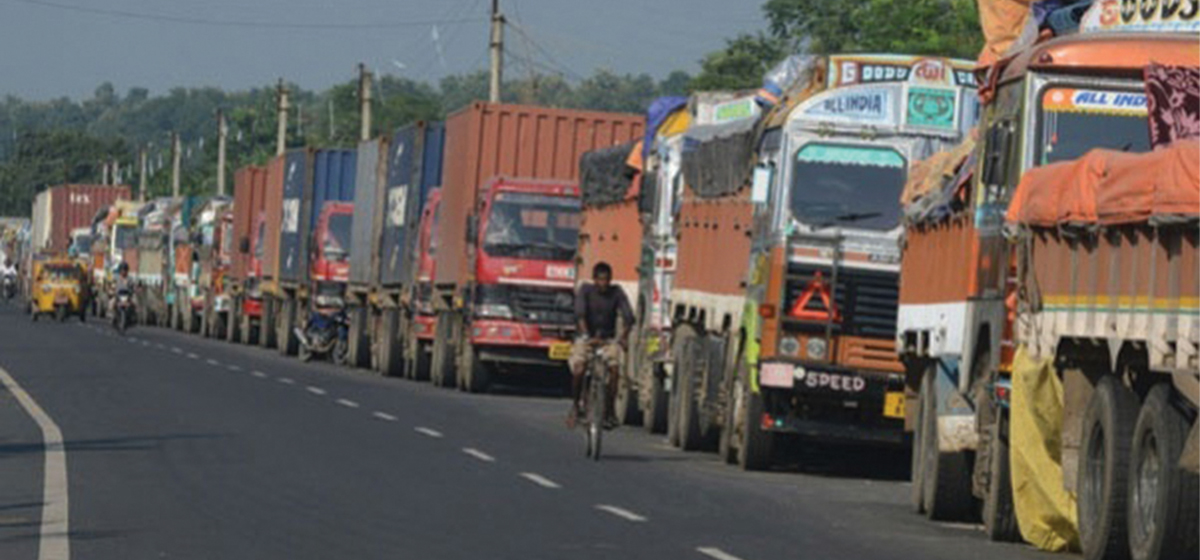
By Dr. Suman Kumar Regmi
Strategically located between China and India, Nepal shipped about US $979.8 million worth of goods around the globe some years ago. That dollar amount showed a 48.4 percent increase before 2015 and a 26.6 percent uptick from 2018 to 2019 and thereafter. The available country-specific data from 2017 shows that 92.6 percent of products exported from Nepal were imported by: India (56.7 percent of the global trade), the US (11.2 percent), Turkey (6.4 percent), Germany (3.9 percent), the UK (3.4 percent), China (3 percent), Italy (1.6 percent), France (1.5 percent), Bangladesh (1.3 percent), Japan (1.3 percent), Canada (1.1 percent), and the UAE (1.1 percent).
Nepal mainly exports carpets, beverages, textiles, tea, yarn, plastic products, soybean oil, sunflower oil, and palm oil, which became the topmost exports of Nepal after FY 2019–20. Nepal’s main export partners include India, the US, Bangladesh, and Germany. Nepal mainly imports fuel, apparel, gold, iron and steel, machinery, and equipment. India, China, the UAE, Indonesia, and Thailand are the main import partners of Nepal. The leading declining items among Nepal’s top ten export items were coffee, tea, and spices, recording a negative 39.5 percent fall. Yarn made from synthetic staple fibres represents Nepal’s most valuable exported product, at 11.3 percent of the country’s total.
Supporting Part
Given Nepal’s population of 28.6 million people, its total US $979.8 million in exports in 2019 amounted to roughly US $35 for every resident of the South Asian country. Nepal’s top ten export items represent the highest dollar value in Nepalese global shipments in 2018 and thereafter. The percentage share of each export type ranged between 25 and 3 percent of overall exports from Nepal.
Nepal’s top exports accounted for 70.9 percent of the overall value of its global shipments. Animal or vegetable fats, oils, and waxes represented the fastest-growing category among the top ten export items, up by 1008 percent from 2018 to 2019. In second position for improving export sales was paper yarn and woven fabric, with a 36.7 percent gain.
Nepal’s shipments of miscellaneous textiles and worn clothes recorded the third-fastest gain in value, up by 11 percent. The leading declining item among Nepal’s top ten export items was unknitted and non-crocheted clothing and accessories (thangkas), with a 10.9 percent year-on-year decline.
Palm oil represents Nepal’s most valuable exported product at 19.3 percent of the country’s total. In second position was yarn made from synthetic staple fibres, sharing 8.3 percent, followed by textile floor coverings including carpets (6.9 percent), soybean oil (5.4 percent), non-alcoholic drinks excluding water/juices or milk (4.2 percent), and miscellaneous plastic items (3.4 percent).
Way Forward: Export Incentives
The government increased export incentives to five percent. Nepal’s exportable goods would now become eligible to receive up to five percent cash incentive, increased from 2 percent, as per the new provision introduced by the government in order to increase export earnings.
Under the provisions made between 2018 and 2025, the government decided to provide cash incentives of 3 to 5 percent based on domestic value addition. Earlier, exporters used to receive cash incentives of 1 to 2 percent provided that the value addition inside the country was at least 30 percent. But this incentive was dropped in FY 2082/83.
After the 2018 provisions, incentives were also provided to goods exported to the southern neighbour. The earlier provisions had provided incentives only for goods exported to third countries.
This change was intended to help control the country’s widening trade deficit. It could also help Nepal earn more foreign currency at a time when the country is facing increasing pressure on its balance of payments due to rising imports.
Incentives of up to five percent to eight percent were given to 15 goods, including processed ghee, processed coffee, handicrafts and wooden crafts, leather goods, handmade paper and its products, processed herbs and oil products, precious stones and jewellery, finished goods made from allo, and mineral water.
The government introduced the cash incentive scheme for exporters through the budget of FY 2010/11, but it collapsed in 2024–25 A.D. Nepal’s exports cover a limited number of goods and remain concentrated in a handful of markets. In the beginning, the government had announced incentives of up to 4 to 8 percent. It was later reduced to 2 percent after the scheme failed to boost exports. The 8 percent export incentive was dropped in 2082 B.S.
(The writer is a former Deputy Executive Director of TEPC under the Ministry of Industry, Commerce and Supplies.)




















Comments:
Leave a Reply